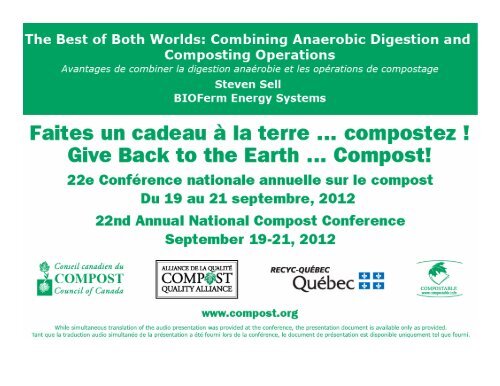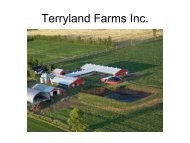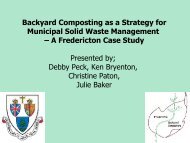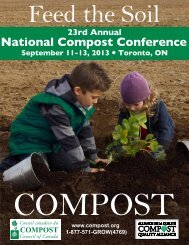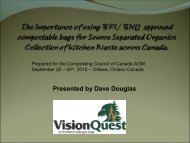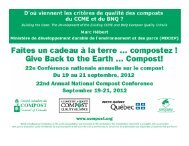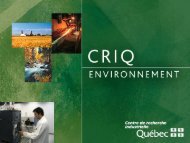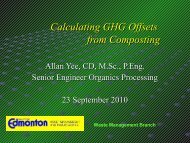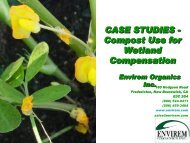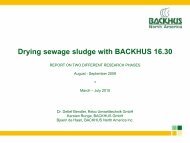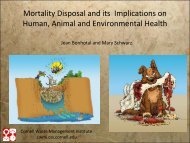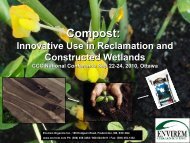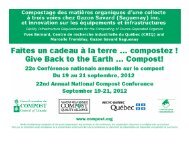Steven Sell, BIOFerm Energy Systems - Compost Council of Canada
Steven Sell, BIOFerm Energy Systems - Compost Council of Canada
Steven Sell, BIOFerm Energy Systems - Compost Council of Canada
Create successful ePaper yourself
Turn your PDF publications into a flip-book with our unique Google optimized e-Paper software.
<strong>BIOFerm</strong> <strong>Energy</strong> <strong>Systems</strong>Combining Anaerobic Digestion and <strong>Compost</strong>ingOperations<strong>Steven</strong> <strong>Sell</strong>September 20, 2012Canadian <strong>Compost</strong> <strong>Council</strong> ConferenceMontréal, QuebecCONFIDENTIAL© <strong>BIOFerm</strong> <strong>Energy</strong> <strong>Systems</strong>12/13/2012Slide 2
ContentCompany IntroductionWaste ReductionExclusive <strong>Compost</strong>ing• Requirements• Emissions• LossesAnaerobic Digestion• Benefits• Dry Fermentation• <strong>Energy</strong> Production• Financing and IncentivesCase Study• Combined AD & <strong>Compost</strong>ing© <strong>BIOFerm</strong> <strong>Energy</strong> <strong>Systems</strong>12/13/2012CONFIDENTIALSlide 3
<strong>BIOFerm</strong> TM <strong>Energy</strong> <strong>Systems</strong>A Company <strong>of</strong> the Viessmann Group• <strong>BIOFerm</strong> is a wholly ownedsubsidiary <strong>of</strong> the Viessmann Group,which was founded in 1917• Comprehensive product range <strong>of</strong>heating and climate control technology• $2 billion worldwide company• North American HQ in Madison, WIsince 2007• Designs and builds biogas plants• Over 330 installations worldwide© <strong>BIOFerm</strong> <strong>Energy</strong> <strong>Systems</strong>12/13/2012CONFIDENTIALSlide 4
Offering AD <strong>Systems</strong> for Most Organic MaterialsSolid Waste ProductsE.g. municipal organic waste,food wasteLiquid Wastee.g. liquid manure<strong>Energy</strong> Cropse.g. corn and grass silageMixed Wastese.g. liquid manure and energy cropLiquid Wastee.g. liquid manureMixed Wastese.g. liquid manure and energy crop© <strong>BIOFerm</strong> <strong>Energy</strong> <strong>Systems</strong>12/13/2012CONFIDENTIALSlide 5
ContentCompany IntroductionWaste ReductionExclusive <strong>Compost</strong>ing• Requirements• Emissions• LossesAnaerobic Digestion• Benefits• Dry Fermentation• <strong>Energy</strong> Production• Financing and IncentivesCase Study• Combined AD & <strong>Compost</strong>ing© <strong>BIOFerm</strong> <strong>Energy</strong> <strong>Systems</strong>12/13/2012CONFIDENTIALSlide 6
Waste Diversionhttp://goingtoseed.wordpress.com/Organic WastesLand Applicationhttp://www.wm.com/sustainability/bioreactor‐landfills/bioreactor‐technologies.jspAnaerobic Digestion/<strong>Compost</strong>ingLandfillCONFIDENTIAL© <strong>BIOFerm</strong> <strong>Energy</strong> <strong>Systems</strong>12/13/2012Slide 7
ContentCompany IntroductionWaste ReductionExclusive <strong>Compost</strong>ing• Requirements• Emissions• LossesAnaerobic Digestion• Benefits• Dry Fermentation• <strong>Energy</strong> Production• Financing and IncentivesCase Study• Combined AD & <strong>Compost</strong>ing© <strong>BIOFerm</strong> <strong>Energy</strong> <strong>Systems</strong>12/13/2012CONFIDENTIALSlide 8
<strong>Compost</strong>ing – Typical Requirements• Additional water required• (50-60% moisture)• Carbon-to-nitrogen ratio between• 20:1 and 30:1• Smaller particle size for efficiency• (< 2 inches)• Free air space• (40 - 60 %)© <strong>BIOFerm</strong> <strong>Energy</strong> <strong>Systems</strong>12/13/2012CONFIDENTIALSlide 9
<strong>Compost</strong>ing – Typical Challenges• Pretreatment• C:N Changes• Separation/Particle Size• Aeration & Mixing• Malodorous emissions• Loss <strong>of</strong> energy• Water use© <strong>BIOFerm</strong> <strong>Energy</strong> <strong>Systems</strong>12/13/2012CONFIDENTIALSlide 10
ContentCompany IntroductionWaste ReductionExclusive <strong>Compost</strong>ing• Requirements• Emissions• LossesAnaerobic Digestion• Benefits• Dry Fermentation• <strong>Energy</strong> Production• Financing and IncentivesCase Study• Combined AD & <strong>Compost</strong>ing© <strong>BIOFerm</strong> <strong>Energy</strong> <strong>Systems</strong>12/13/2012CONFIDENTIALSlide 11
Anaerobic Digestion - Benefits• Minimal additional water required• Material stays stationary, while bacteria (percolate)is sprayed over it to accelerate the decompositionprocess• The input material is reduced by up to 40% andenergy is extracted in the process• The end product (digestate) can be furthercomposted to make commercial grade compost orcan be land applied as a fertilizer• Gaseous/Odor emissions are captured and treated© <strong>BIOFerm</strong> <strong>Energy</strong> <strong>Systems</strong>12/13/2012CONFIDENTIALSlide 12
Anaerobic Digestion – Dry FermentationDry Fermentation Process Layout© <strong>BIOFerm</strong> <strong>Energy</strong> <strong>Systems</strong>12/13/2012CONFIDENTIALSlide 13
ContentCompany IntroductionWaste ReductionExclusive <strong>Compost</strong>ing• Requirements• Emissions• LossesAnaerobic Digestion• Benefits• Dry Fermentation• <strong>Energy</strong> Production• Financing and IncentivesCase Study• Combined AD & <strong>Compost</strong>ing© <strong>BIOFerm</strong> <strong>Energy</strong> <strong>Systems</strong>12/13/2012CONFIDENTIALSlide 14
Case Study – Waste StreamFood and Yard Waste Acquired from:• Supermarkets• Restaurants• Food Processors• MunicipalitiesIngredients Food Wastes Yard Waste TOTALAmount38,500tons/year21,500tons/year60,000tons/yearTotal Solids (%) 1 24.1 59.9 36.8C:N Ratio 1 14.9 54.7 19.81Values obtained from “Developing <strong>Compost</strong>ing Recipes for Process Control.” Biocycle Dec. 2011CONFIDENTIAL© <strong>BIOFerm</strong> <strong>Energy</strong> <strong>Systems</strong>12/13/2012Slide 15
Case Study – <strong>Compost</strong>ing OnlyInput MaterialsOutput MaterialsFood & Yard Waste60,000 tons/yearShredded CardboardFinished <strong>Compost</strong>33,725 tons/year14,945 tons/yearhttp://www.bearpathfarm.com/how_BPF_makes_compost.html<strong>Energy</strong> & Water LossCO 2 NH 3© <strong>BIOFerm</strong> <strong>Energy</strong> <strong>Systems</strong>12/13/2012CONFIDENTIALSlide 16
Case Study – Anaerobic Digestion & <strong>Compost</strong>ingFood & Yard Waste60,000 tons/yearBiogas Production18,600 MWh/yearLiquid FertilizerFinished <strong>Compost</strong>21,190 tons/yearDigestate38,630 tons/yearShredded Cardboard14,350 tons/yearCONFIDENTIALhttp://www.bearpathfarm.com/how_BPF_makes_compost.html© <strong>BIOFerm</strong> <strong>Energy</strong> <strong>Systems</strong>12/13/2012Slide 17
Case Study – Yearly Cost SavingsRevenues AD & <strong>Compost</strong>ing <strong>Compost</strong>ing OnlyTipping Fees($32/ton) $1,920,000 $1,920,000Electricity Generation($0.08/kWh) $1,484,422 $0Thermal Generation($10.50 MMBTU) $677,618 $0Finished Solids($15/cubic yard) $706,400 $1,124,160Liquid Digestate($6/ton) $63,450 $0TOTALS $4,851,890 $3,044,160© <strong>BIOFerm</strong> <strong>Energy</strong> <strong>Systems</strong>12/13/2012CONFIDENTIALSlide 18
Case Study – Summary• Net annual difference in favor <strong>of</strong> AD/<strong>Compost</strong>ing• $4,851,890 - $3,044,160 = $1,807,730 per year• <strong>Energy</strong> is harvested• Nutrients retained• NPK In = NPK Out• Lower amount <strong>of</strong> waste processing• Better odor emissions control© <strong>BIOFerm</strong> <strong>Energy</strong> <strong>Systems</strong>12/13/2012CONFIDENTIALSlide 19
Thank you!<strong>BIOFerm</strong> TM <strong>Energy</strong> <strong>Systems</strong>617 N. Segoe Road, Suite 202PO Box 5408Madison, WI 53705Tel (608) 467-5523www.bi<strong>of</strong>ermenergy.com/usinfo@bi<strong>of</strong>ermenergy.comStop by <strong>BIOFerm</strong>’s Booth (#15) for more Information© <strong>BIOFerm</strong> <strong>Energy</strong> <strong>Systems</strong>12/13/2012CONFIDENTIALSlide 20


